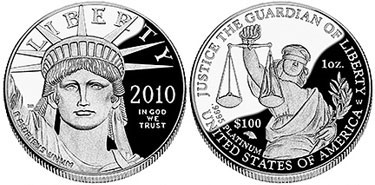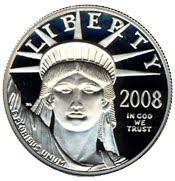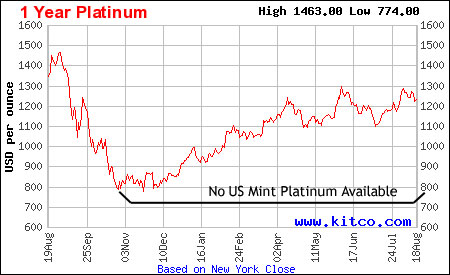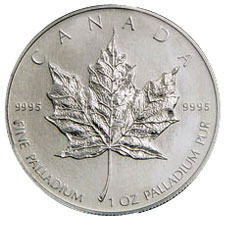The United States Mint began selling 2010 American Platinum Eagles this week– not the bullion coins, but the collectible proof version of the coin.

Platinum bullion coins actually have not been produced by the US Mint since late 2008. The 2009-dated bullion coins were announced canceled as part of a broader announcement, citing “unprecedented demand” for gold and silver bullion coins. There have been no specific updates on the status of platinum bullion coins for the current year.
The one ounce proof 2010 Platinum Eagles are limited to a maximum mintage of 10,000 coins. The initial sales price was set at $1,892. In the absence of bullion versions of the American Platinum Eagle, will this offering have a broader appeal from precious metals investors, rather than just coin collectors?
At the current price, the one ounce proof coins carry a premium of nearly 25% above the current price of platinum. By comparison, a well known bullion dealer has one ounce Platinum Maple Leaf coins available for $1,645 each, or one ounce Platinum Eagles priced at $1,725. These prices represent premiums of 8.22% and 13.49%.
Pricing for the US Mint’s 2010 Proof Platinum Eagle is tiered and based on a weekly average price of platinum, which presents an opportunity to wait for a more favorable price. Assuming the coins do not sell out and platinum prices remain around the current levels, prices for the coins should actually be decreased by $100 on Wednesday of next week. If the price does decline to $1,792 per coin and platinum stays at $1,520 per ounce, the premium above platinum value would be cut down to 17.89%. At around 4.4% more than the premium for random date, bullion quality American Platinum Eagles, precious metals investors may be enticed.
The 2009 Proof Platinum Eagles, which were limited to 8,000 coins, managed to sell out after about a week. The coins now sell for around $2,400 each due to demand from the collector market.
 Although gold and silver are experiencing a sharp decline today, they recorded strong performance during the second quarter of 2010. Platinum and palladium both posted declines for second quarter, but maintain gains for the year to date.
Although gold and silver are experiencing a sharp decline today, they recorded strong performance during the second quarter of 2010. Platinum and palladium both posted declines for second quarter, but maintain gains for the year to date. Despite the fact that the
Despite the fact that the  For the first time since
For the first time since 
 The Royal Canadian Mint has revived two bullion coin programs that had been previously been suspended for a number of years. This includes the Platinum Maple Leaf, with bullion coins already available, and the Palladium Maple Leaf, which is planned for later this year.
The Royal Canadian Mint has revived two bullion coin programs that had been previously been suspended for a number of years. This includes the Platinum Maple Leaf, with bullion coins already available, and the Palladium Maple Leaf, which is planned for later this year. ETF Securities USA recently filed with the SEC to launch exchange traded funds covering platinum and palladium. There are currently no exchange traded funds covering these metals available in the United States.
ETF Securities USA recently filed with the SEC to launch exchange traded funds covering platinum and palladium. There are currently no exchange traded funds covering these metals available in the United States.